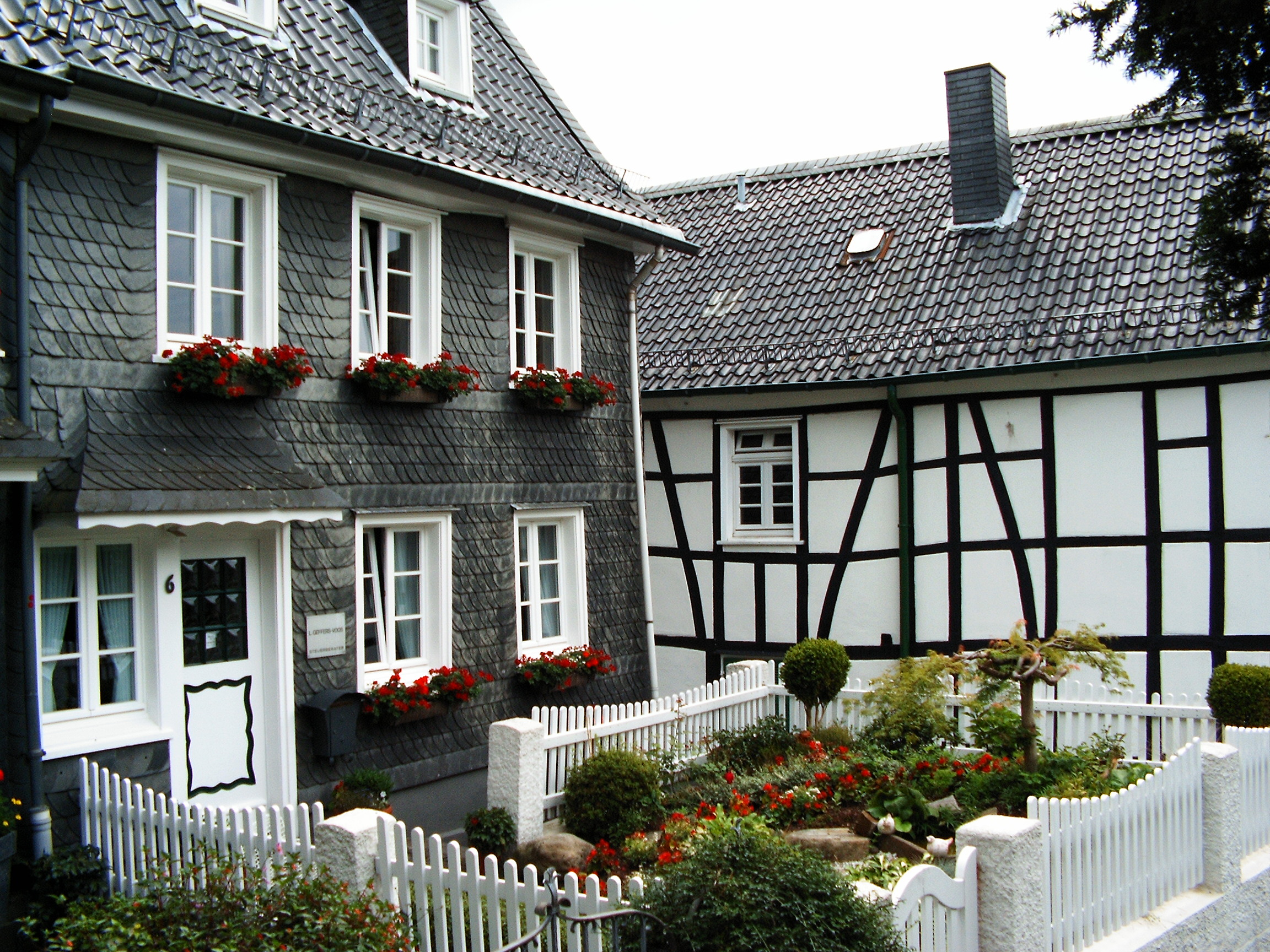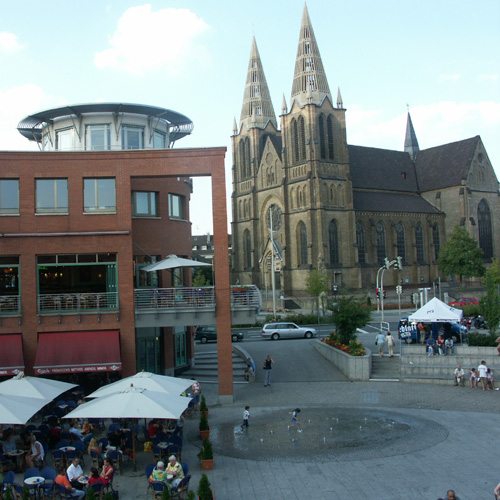|
Solingen Hbf
Solingen Hauptbahnhof is the only railway station in Solingen, Germany, to be served by ICE and IC long distance trains. Solingen-Mitte station serves central Solingen, but only has Regionalbahn trains. History The first station in the area of present-day town of Solingen was built with the opening of the Gruiten-Cologne-Mülheim railway by the Bergisch-Märkische Railway Company. The station opened on 25 September 1867 and was named ''Ohligs Wald'' ("Ohligs forest"). That same year a branch line to Solingen was built from this station. In 1890, the ''Wald'' part of the name was dropped and with the incorporation of Ohligs into Solingen in 1929, the station was renamed ''Solingen-Ohligs''. In 1894, the line from Hilden was opened. The importance of the Solingen-Ohligs station always exceeded that of the other stations in Solingen, including the old ''Solingen Hauptbahnhof'', since only Ohligs station is located on a main line. Consequently, it was the stopping point for long ... [...More Info...] [...Related Items...] OR: [Wikipedia] [Google] [Baidu] |
Solingen
Solingen (; li, Solich) is a city in North Rhine-Westphalia, Germany. It is located some 25 km east of Düsseldorf along the northern edge of the region called Bergisches Land, south of the Ruhr area, and, with a 2009 population of 161,366, is after Wuppertal the second-largest city in the Bergisches Land. It is a member of the regional authority of the Rhineland. Solingen is called the "City of Blades", since it has long been renowned for the manufacturing of fine swords, knives, scissors and razors made by famous firms such as WKC Stahl- und Metallwarenfabrik, WKC, DOVO Solingen, DOVO, Wüsthof, J. A. Henckels, Zwilling J. A. Henckels, Böker, Güde, Hubertus, Diefenthal, Puma, Clauberg, Eickhorn, Linder, Carl Schmidt Sohn, Dreiturm, Herder, and numerous other manufacturers. In medieval times, the swordsmiths of Solingen designed the town's coat of arms, which continues to the present. In the latter part of the 17th century, a group of swordsmiths from Solingen broke thei ... [...More Info...] [...Related Items...] OR: [Wikipedia] [Google] [Baidu] |
S1 (Rhine-Ruhr S-Bahn)
Line S1 is a S-Bahn line on the Rhine-Ruhr network. It is operated by DB Regio. It runs from Dortmund via Bochum and Essen to Duisburg. From there it travels south to Düsseldorf and Hilden before continuing to Solingen. It is operated on weekdays at 15-minute intervals between Dortmund Hbf and Essen Hbf, at 20-minute intervals between Düsseldorf Hbf and Solingen and at 30-minute intervals between Düsseldorf and Essen, using coupled sets of class 422 four-car electrical multiple units. Line S 1 runs over lines built by various railway companies: * from Dortmund Hauptbahnhof to Duisburg over the Witten/Dortmund–Oberhausen/Duisburg railway, opened by the Bergisch-Märkische Railway Company in 1862, * from Duisburg to Düsseldorf-Oberbilk over the Cologne–Duisburg railway, opened by the Cologne-Minden Railway Company in 1845 and * from Düsseldorf-Oberbilk to Solingen over the Düsseldorf–Solingen railway opened by the Prussian state railways between 1891 and 1894. S-Bah ... [...More Info...] [...Related Items...] OR: [Wikipedia] [Google] [Baidu] |
Rhine-Ruhr S-Bahn Stations
The Rhine-Ruhr metropolitan region (german: Metropolregion Rhein-Ruhr) is the largest metropolitan region in Germany, with over ten million inhabitants. A polycentric conurbation with several major urban concentrations, the region covers an area of , entirely within the federal state of North Rhine-Westphalia. The Rhine-Ruhr metropolitan region spreads from the Ruhr area (Dortmund-Essen-Duisburg-Bochum) in the north to the urban areas of the cities of Mönchengladbach, Düsseldorf (the state capital), Wuppertal, Leverkusen, Cologne (the region's largest and Germany's fourth largest city), and Bonn in the south. The location of the Rhine-Ruhr at the heart of the European Blue Banana makes it well connected to other major European cities and metropolitan areas such as the Randstad, the Flemish Diamond and the Frankfurt Rhine Main Region. The metropolitan area is named after the Rhine and Ruhr rivers, which are the region's defining geographical features and historically its ... [...More Info...] [...Related Items...] OR: [Wikipedia] [Google] [Baidu] |
1867 Establishments In Prussia
Events January–March * January 1 – The Covington–Cincinnati Suspension Bridge opens between Cincinnati, Ohio, and Covington, Kentucky, in the United States, becoming the longest single-span bridge in the world. It was renamed after its designer, John A. Roebling, in 1983. * January 8 – African-American men are granted the right to vote in the District of Columbia. * January 11 – Benito Juárez becomes Mexican president again. * January 30 – Emperor Kōmei of Japan dies suddenly, age 36, leaving his 14-year-old son to succeed as Emperor Meiji. * January 31 – Maronite nationalist leader Youssef Bey Karam leaves Lebanon aboard a French ship for Algeria. * February 3 – ''Shōgun'' Tokugawa Yoshinobu abdicates, and the late Emperor Kōmei's son, Prince Mutsuhito, becomes Emperor Meiji of Japan in a brief ceremony in Kyoto, ending the Late Tokugawa shogunate. * February 7 – West Virginia University is established in Morgantown, West Virginia. * February 13 ... [...More Info...] [...Related Items...] OR: [Wikipedia] [Google] [Baidu] |
Railway Stations In Germany Opened In 1867
Rail transport (also known as train transport) is a means of transport that transfers passengers and goods on wheeled vehicles running on rails, which are incorporated in tracks. In contrast to road transport, where the vehicles run on a prepared flat surface, rail vehicles (rolling stock) are directionally guided by the tracks on which they run. Tracks usually consist of steel rails, installed on sleepers (ties) set in ballast, on which the rolling stock, usually fitted with metal wheels, moves. Other variations are also possible, such as "slab track", in which the rails are fastened to a concrete foundation resting on a prepared subsurface. Rolling stock in a rail transport system generally encounters lower frictional resistance than rubber-tyred road vehicles, so passenger and freight cars (carriages and wagons) can be coupled into longer trains. The operation is carried out by a railway company, providing transport between train stations or freight customer facili ... [...More Info...] [...Related Items...] OR: [Wikipedia] [Google] [Baidu] |
Railway Stations In North Rhine-Westphalia
Rail transport (also known as train transport) is a means of transport that transfers passengers and goods on wheeled vehicles running on rails, which are incorporated in tracks. In contrast to road transport, where the vehicles run on a prepared flat surface, rail vehicles (rolling stock) are directionally guided by the tracks on which they run. Tracks usually consist of steel rails, installed on sleepers (ties) set in ballast, on which the rolling stock, usually fitted with metal wheels, moves. Other variations are also possible, such as "slab track", in which the rails are fastened to a concrete foundation resting on a prepared subsurface. Rolling stock in a rail transport system generally encounters lower frictional resistance than rubber-tyred road vehicles, so passenger and freight cars (carriages and wagons) can be coupled into longer trains. The operation is carried out by a railway company, providing transport between train stations or freight customer faciliti ... [...More Info...] [...Related Items...] OR: [Wikipedia] [Google] [Baidu] |
Deutsche Bahn
The (; abbreviated as DB or DB AG) is the national railway company of Germany. Headquartered in the Bahntower in Berlin, it is a joint-stock company ( AG). The Federal Republic of Germany is its single shareholder. describes itself as the second-largest transport company in the world, after the German postal and logistics company / DHL, and is the largest railway operator and infrastructure owner in Europe. Deutsche Bahn was the largest railway company in the world by revenue in 2015; in 2019, DB Passenger transport companies carried around 4.8 billion passengers, and DB logistics companies transported approximately 232 million tons of goods in rail freight transport. The group is divided into several companies, including ''DB Fernverkehr'' (long-distance passenger), '' DB Regio'' (local passenger services) and ''DB Cargo'' (rail freight). The Group subsidiary ''DB Netz'' also operates large parts of the German railway infrastructure, making it the largest rail network in ... [...More Info...] [...Related Items...] OR: [Wikipedia] [Google] [Baidu] |
Ohligs
Solingen (; li, Solich) is a city in North Rhine-Westphalia, Germany. It is located some 25 km east of Düsseldorf along the northern edge of the region called Bergisches Land, south of the Ruhr area, and, with a 2009 population of 161,366, is after Wuppertal the second-largest city in the Bergisches Land. It is a member of the regional authority of the Rhineland. Solingen is called the "City of Blades", since it has long been renowned for the manufacturing of fine swords, knives, scissors and razors made by famous firms such as WKC, DOVO, Wüsthof, Zwilling J. A. Henckels, Böker, Güde, Hubertus, Diefenthal, Puma, Clauberg, Eickhorn, Linder, Carl Schmidt Sohn, Dreiturm, Herder, and numerous other manufacturers. In medieval times, the swordsmiths of Solingen designed the town's coat of arms, which continues to the present. In the latter part of the 17th century, a group of swordsmiths from Solingen broke their guild oaths by taking their sword-making secrets with them t ... [...More Info...] [...Related Items...] OR: [Wikipedia] [Google] [Baidu] |
Bergisch-Märkische Railway Company
The Bergisch-Markisch Railway Company (german: Bergisch-Märkische Eisenbahn-Gesellschaft, BME), also referred to as the Berg-Mark Railway Company or, more rarely, as the Bergisch-Markische Railway Company, was a German railway company that together with the Cologne-Minden Railway (''Cöln-Mindener Eisenbahn-Gesellschaft'', ''CME'') and the Rhenish Railway Company (''Rheinische Eisenbahn-Gesellschaft'', ''RhE'') was one of the three (nominally) private railway companies that in the mid-19th century built the first railways in the Ruhr and large parts of today's North Rhine-Westphalia. Its name refers to Bergisches Land and the County of Mark. History Foundation The Bergisch-Markisch Railway Company was founded on 18 October 1843 in Elberfeld (Today Wuppertal). Since the Cologne-Minden Railway Company had decided to build its route via Duisburg rather than through the valley of the Wupper river, the Bergisch-Markisch Railway Company (german: Bergisch-Märkische Eisenbahn-Gesellscha ... [...More Info...] [...Related Items...] OR: [Wikipedia] [Google] [Baidu] |
Solingen-Mitte Station
Solingen Mitte station is in the city of Solingen in the German state of North Rhine-Westphalia. It is on the Wuppertal-Oberbarmen–Solingen railway. The line through the site of Solingen Mitte station was opened on 2 December 1890 as part of the Solingen–Wuppertal-Vohwinkel line, known as the ''Korkenzieherbahn'' ("Corkscrew Railway"), to Vohwinkel. The station was opened on 10 December 2006. It is classified by Deutsche Bahn as a category 5 station. The station is served by line S 7 of the Rhine-Ruhr S-Bahn, branded as ''Der Müngstener'', operated every 20 minutes from Monday to Friday and generally every half hour on weekends and at off-peak times, using (LINT 41) vehicles. Until 15 December 1913 the station was served by Regional-Express service RB 47, operated by DB Regio NRW, normally with two-carriage sets of class 628.4. The Abellio Deutschland company won a contract that was put to tender in November 2010 and took over the operation of passenger services on the ro ... [...More Info...] [...Related Items...] OR: [Wikipedia] [Google] [Baidu] |
North Rhine-Westphalia
North Rhine-Westphalia (german: Nordrhein-Westfalen, ; li, Noordrien-Wesfale ; nds, Noordrhien-Westfalen; ksh, Noodrhing-Wäßßfaale), commonly shortened to NRW (), is a States of Germany, state (''Land'') in Western Germany. With more than 18 million inhabitants, it is the List of German states by population, most populous state of Germany. Apart from the city-states, it is also the List of German states by population density, most densely populated state in Germany. Covering an area of , it is the List of German states by area, fourth-largest German state by size. North Rhine-Westphalia features 30 of the 81 German municipalities with over 100,000 inhabitants, including Cologne (over 1 million), the state capital Düsseldorf, Dortmund and Essen (all about 600,000 inhabitants) and other cities predominantly located in the Rhine-Ruhr metropolitan area, the largest urban area in Germany and the fourth-largest on the European continent. The location of the Rhine-Ruhr at the h ... [...More Info...] [...Related Items...] OR: [Wikipedia] [Google] [Baidu] |








.jpg)